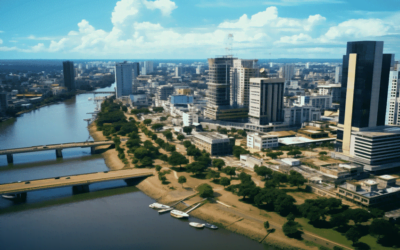Hey there, fellow drone enthusiast or anyone curious about Sweden’s drone laws! I get why you might be searching for information on this topic. Diving into the world of drones is incredibly exciting, but navigating the legal aspects can be a tad overwhelming, right?
Whether you’re a seasoned drone pilot or a newbie eager to explore the Swedish skies, understanding the drone laws in Sweden is vital for a safe and enjoyable experience.
Well, guess what? You’re in the right place! I’ve delved deep into the realm of Sweden’s drone regulations, and I’m here to share what I’ve uncovered. My journey involved scouring official documents, connecting with experts, and even testing the waters (or skies) myself.
So, when it comes to Sweden’s drone laws, you can rest assured that I’ve got the lowdown on what you need to know.
If you’re seeking clarity on Sweden’s drone laws, you’re in for a treat. This article is here to provide you with all the answers and guidance you need.
From understanding the registration requirements to steering clear of no-fly zones and staying up-to-date with the latest changes, we’ve got it all covered. So, hang tight and read on, because by the end of this article, you’ll be well-equipped to navigate Sweden’s drone laws with confidence. Let’s get started!
Navigating the Drone Categories and Registration in Sweden

Alright, let’s dive into the intriguing world of drone registration and categorization in Sweden. If you’re a drone enthusiast like me, understanding the ins and outs of these regulations is crucial for smooth flying.
Categorization of Drones in Sweden
In Sweden, drones are categorized based on their weight and purpose. It’s like a special club with different rules for each category. First up, the weight. If your drone tips the scales at more than 250 grams, you’ll likely need to step into the registration game.
Now, let’s talk purpose. Are you flying for fun or profit? If it’s the former, you’re in the recreational category. If it’s the latter, you’re venturing into the commercial realm.
You see, these categories help tailor the regulations to fit the drone’s size and the operator’s intentions. It’s all about ensuring safety while letting you enjoy the skies.
Registration Requirements for Drones in Sweden
Now, let’s get down to brass tacks. Registration – it’s the official handshake between you and Swedish authorities. If your drone falls into the “over 250 grams” club or you’re running a commercial operation, get ready to do some paperwork.
Registration requirements are in place to keep track of drones and their operators. It’s like a friendly “hello” to the authorities to say, “Hey, I’m here, and I’m flying safely.” This step helps ensure accountability, especially if your drone becomes a free spirit for some reason.
Recreational vs. Commercial Drone Operation
The distinction between recreational and commercial drone operations is a big deal. For recreational flyers, the rules are a bit more relaxed, focusing on safety while you’re having fun.
But if you’re using your drone for profit or other economic activities, you need to jump through a few more hoops. Commercial drone operators have added responsibilities and might need insurance coverage.
It’s essential to know which category you fall into, so you can follow the right set of rules. Whether you’re a weekend flyer capturing stunning landscapes or running a drone photography business, knowing your category is key to staying on the right side of the law.
Also Read: Suriname Drone Laws 2024
Navigating Sweden’s No-Fly Zones

Now, let’s embark on a journey through Sweden’s no-fly zones. These areas aren’t just off-limits for kicks; they’re there for critical reasons. So, what’s the deal with no-fly zones in this Scandinavian beauty?
Identification of Restricted Areas
Sweden’s no-fly zones are kind of like the “do not enter” signs for your drone. You’ll find them around places like airports, military installations, and sensitive locations. Airports are pretty self-explanatory; drones and planes don’t mix well.
But what about military zones? Well, they’re a big red flag because of security concerns. And sensitive areas? Think about national parks or places where nature is left undisturbed.
They’re not keen on drones either. Knowing where these no-fly zones are is essential to avoid unwanted trouble and respect the rules.
Consequences of Flying in No-Fly Zones
So, what happens if you ignore those no-fly zones? It’s not just a mild slap on the wrist; the consequences can be pretty serious. You’re not only putting your drone at risk but also the people and property around you. The authorities take this stuff seriously. Penalties can range from fines to legal action. Flying in a no-fly zone is a recipe for drone disaster, so it’s best to steer clear.
Tools and Resources for Checking No-Fly Zones in Sweden
Don’t worry; you’re not alone in this journey. There are tools and resources at your disposal to help you stay within the legal flight zones.
Various apps and websites can provide real-time data on no-fly zones, making it easy for you to plan your flights accordingly. It’s like having a friendly GPS for your drone, keeping you on the right flight path. Knowing where not to fly is just as important as knowing where to fly safely.
Also Read: Sudan, South Drone Laws 2024
Navigating the Skies Responsibly

As drone enthusiasts, we all share the same goal: to enjoy our drones while keeping everyone safe. Understanding the flight rules and best practices in Sweden is a crucial part of that. So, let’s uncover what it takes to fly responsibly in this beautiful country.
Maintaining the Visual Line of Sight
One of the golden rules of drone operation is maintaining a visual line of sight. It’s like keeping your drone within arm’s reach.
You’ve got to keep an eye on it, literally. This rule ensures that you can react quickly to any unforeseen obstacles or situations. It’s a bit like driving a car – you wouldn’t do it blindfolded, right? So, keeping your drone in sight at all times is a fundamental safety practice.
Altitude Limits for Drone Flights
Altitude is another vital aspect of responsible drone operation. In Sweden, drones are typically limited to a specific altitude. This rule is in place to keep drones away from manned aircraft and to prevent interference with aviation traffic.
Staying within these altitude limits not only keeps you on the right side of the law but also contributes to overall airspace safety.
Prohibitions on Flying Over People or Gatherings
Flying over people or gatherings without proper permission is generally a no-go. It’s all about ensuring the safety of those on the ground.
If your drone happens to malfunction or lose control, flying over people can pose significant risks. And let’s not forget the privacy aspect – respecting people’s personal space is a given.
Tips for Responsible and Safe Drone Use
Now, let’s wrap up with some handy tips for responsible and safe drone use. Always conduct a pre-flight check, ensuring your drone is in excellent condition. Be mindful of weather conditions; strong winds and heavy rain are not your drone’s friends.
And most importantly, respect people’s privacy and property while capturing those stunning aerial shots. Remember, flying responsibly not only keeps you within the law but also fosters a positive image for drone enthusiasts everywhere.
Also Read: Sudan Drone Laws 2024
The Importance of Liability Insurance

Alright, fellow drone enthusiasts, let’s talk insurance – specifically, liability insurance for drone operators in Sweden. Whether you’re flying drones for fun or profit, understanding the need for this type of coverage is vital for a worry-free flight experience.
Requirement for Liability Insurance
In Sweden, the requirement for liability insurance primarily applies to commercial drone operators. When you’re making money from those captivating aerial shots, it’s essential to have a safety net in place.
Liability insurance comes into play to protect you and others in case of accidents or mishaps during your commercial drone operations. It’s like a safety cushion to cover potential damages, giving you peace of mind as you soar through the skies.
Obtaining Insurance Coverage
So, where can you get your hands on this valuable liability insurance? Many insurance providers in Sweden offer drone-specific policies tailored to your needs. It’s essential to do some research and compare options to find the one that suits you best.
Be sure to consider the coverage limits, terms, and costs. While it might be an additional expense, it’s a responsible and necessary step to ensure you’re fully covered while enjoying the drone adventure, especially in the commercial arena.
Also Read: Sri Lanka Drone Laws 2024
The Future of Drone Identification

Let’s talk about a game-changer in the world of drone regulation – remote identification. It’s a hot topic in Sweden and around the globe, and it’s essential to understand what’s brewing in this space.
Emerging Regulations on Remote Identification
Remote identification is all about making drones easily identifiable and traceable. This emerging regulation is aimed at enhancing safety, security, and accountability in the drone ecosystem.
While it’s not a fully implemented law yet, Sweden, like many other countries, is exploring ways to ensure that every drone in the sky can be remotely identified. This means no anonymous drone flights, and it’s a significant step toward safer and more responsible drone use.
Importance of Remote ID for Tracking and Accountability
So, why is remote identification a big deal? Well, it’s all about accountability. With remote ID, authorities can track a drone’s flight path and operator in real-time. This helps in monitoring flights near no-fly zones and during emergencies, ensuring a swift and coordinated response.
Moreover, it’s a critical tool for identifying rogue drones and preventing potential security threats. While these regulations may come with some adjustments for drone operators, they play a crucial role in making the skies a safer place for everyone.
Also Read: Spain Drone Laws 2024
Staying in the Loop with Drone Law Changes

As drone enthusiasts, we know that the world of regulations is ever-evolving. It’s essential to keep our antennas up for any updates in Sweden’s drone laws. So, what’s new in the world of Swedish drone regulations?
Updates on Recent Changes
Recent changes in Sweden’s drone laws may have an impact on your flights. Keeping an eye on updates is vital. Whether it’s new registration requirements, altered no-fly zones, or additional safety guidelines, staying informed is key to ensuring your drone operations are compliant and safe.
Anticipation of Future Developments
The future of drone regulations is never set in stone. The authorities are constantly working to adapt to the changing landscape of drone technology. Anticipating future developments in drone laws helps you prepare and stay ahead of the game.
It’s an exciting yet dynamic field, and staying informed about what’s on the horizon can help you make well-informed decisions as a responsible drone operator.
Your Go-To Resources for Drone Law Knowledge
Here’s the scoop: staying informed about Sweden’s drone laws is the key to safe and enjoyable flights. But where can you find all the essential info and tools? Let’s explore some valuable resources and references to keep you in the know.
Official Sources for Up-to-Date Information
The Swedish Transport Agency is your best buddy when it comes to official and up-to-date information on drone regulations.
Their website is a treasure trove of knowledge, offering guidance, documents, and contact information if you ever need to reach out with specific questions. It’s like the holy grail of drone law wisdom.
Links to Relevant Documents and Guidelines
When you’re diving into the nitty-gritty details, official documents and guidelines can be your best friends.
They provide the legal framework, so you can understand the ins and outs of drone laws. You’ll find links to these documents on the Swedish Transport Agency’s website, giving you access to the official texts that shape the rules.
Suggested Apps and Online Tools
In this digital age, apps and online tools have become indispensable for drone operators. To stay clear of no-fly zones, plan your flights, and ensure safety, consider using apps like Air Map and UAV Forecast.
These user-friendly tools provide real-time data and weather information, making your drone operations smoother and safer. They’re like the GPS for your drone adventures, ensuring you have a blast while staying on the right side of the law.
Also Read: South Africa Drone Laws 2024
Final Thought On Sweden Drone Laws

As our journey through Sweden’s drone laws comes to a close, let’s take a moment to recap the essentials, reminding ourselves why it’s crucial to be well-versed in these regulations.
In Sweden, understanding the categorization of drones based on weight and purpose is the first step. Whether you’re flying for fun or profit, knowing your category helps tailor the rules to your unique situation.
No-fly zones are like checkpoints on your drone adventure, and respecting them is vital for safety and compliance. Then there are flight rules and best practices, covering everything from maintaining line of sight to altitude limits and responsible flying over people.
Don’t forget about liability insurance, especially if you’re in the commercial drone game. Lastly, keep an eye on emerging regulations like remote identification, as they shape the future of drone operations.
Adhering to Sweden’s drone laws isn’t just about following the rules; it’s about ensuring safety in the skies. Compliance not only protects your drone but also the people and property around you.
By staying within the law, you contribute to a positive image of responsible drone operation and help maintain a safe environment for all.
As drone enthusiasts, we’re all part of a vibrant community. So, I’d like to encourage you to stay informed and continue following the law when using drones in Sweden.
It’s an exciting world up there, and with the right knowledge and a responsible approach, you can explore the Swedish skies while ensuring the safety and enjoyment of everyone around you. Fly high, fly safe, and enjoy the beauty of Sweden from a whole new perspective.
Also Read: Somalia Drone Laws 2024
Frequently Asked Questions
1. Do I need to register my drone in Sweden, and how does the categorization work?
Yes, you may need to register your drone in Sweden. The categorization is based on weight and purpose. Drones over 250 grams typically require registration. If you’re flying for fun, you’re in the recreational category; if it’s for profit, you’re in the commercial category.
2. What are the consequences of flying in a no-fly zone in Sweden?
Flying in no-fly zones can lead to serious consequences. It not only risks your drone but can also result in penalties or legal action. It’s crucial to avoid restricted areas, including airports, military zones, and sensitive locations.
3. Is liability insurance necessary for drone operators in Sweden?
Liability insurance is particularly important for commercial drone operators in Sweden. It provides protection in case of accidents or damages during commercial operations. Many insurance providers offer drone-specific policies to ensure coverage.
4. What is remote identification, and why is it significant for drone operators in Sweden?
Remote identification is a growing regulatory requirement in Sweden and around the world. It aims to make drones easily identifiable and traceable for safety and security reasons. Authorities can track drones and operators in real-time, enhancing accountability and preventing security threats.
5. Where can I find official resources and references for staying informed about Sweden’s drone laws?
The Swedish Transport Agency is a valuable resource for up-to-date information on drone regulations. Their website provides official documents and guidance. Additionally, there are apps like AirMap and UAV Forecast that can help you with real-time data, weather information, and flight planning.












